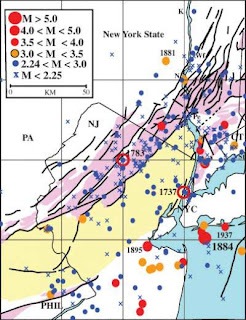New Study Says New York City Is At Risk For A Massive Earthquake
 Friday, August 22, 2008 at 10:19AM
Friday, August 22, 2008 at 10:19AM 
The study published in the Bulletin of the Seismological Society of America, says that the New York City area is at "substantially greater" risk of earthquakes than previously thought, scientists said Thursday.
Damage could range from minor to major, with a rare but potentially powerful event killing people and costing billions of dollars in damage.
A pattern of subtle but active faults is known to exist in the region, and now new faults have been found. The scientists say that among other things, the Indian Point nuclear power plants, 24 miles north of the city, sit astride the previously unidentified intersection of two active seismic zones.
Earthquakes are rare on the East Coast, but they have happened. In 1737, a 5.0 earthquake crumbled chimneys in New York City and the tremors were felt all the way from Boston to Philadelphia, according to LiveScience.com. Less than 50 years later, another quake hit the region, the Web site reported. Then in 1884, a 5.5 earthquake wreaked havoc similar to that caused by the 1737 quake, although the 19th century one affected a wider region.Researchers said earthquakes of at least 5.0 in magnitude should occur every 100 years, based on their study of 383 earthquakes dating from 1677 to 2007 in a 15,000-square-mile area around New York City and 34 years of new tremblor data, LiveScience.com said.
Despite the infrequency of quakes on the East Coast, the amount and concentration of people and infrastructure make it a particularly risky situation -- one the New York City Area Consortium for Earthquake Loss Mitigation said could cost anywhere from $39 billion to $197 billion, according to LiveScience.
"Today, with so many more buildings and people, a magnitude 5 centered below the city would be extremely attention-getting," John Armbruster, of Columbia University's Lamont-Doherty Earth Observatory, told LiveScience.com. "We'd see billions in damage, with some brick buildings falling. People would probably be killed."
It's possible even magnitude-6 or 7 quakes could strike the area, which could cause 10 to 100 times the damage of a magnitude-5.0, researchers said. A key concern is that earthquakes on the East Coast can't be seen at the surface, which means it could hit from a fault no one knew about.
New Faults have been found near the Indian Point nuclear power plant less than 25 miles north of NYC.
 Earthquake,
Earthquake,  NYC,
NYC,  New York,
New York,  News
News 







